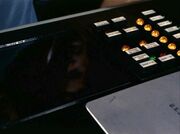m (fm) |
m (Bot: Automated text replacement (-weapons +weapons) !!wikia-credits fix!!) |
||
| Line 7: | Line 7: | ||
[[File:Transporter console, 23rd century.jpg|thumb|Standard [[duotronic]] transporter console (c. [[2260s]])]] |
[[File:Transporter console, 23rd century.jpg|thumb|Standard [[duotronic]] transporter console (c. [[2260s]])]] |
||
| − | The console allows the operator to monitor various functions of the transporter system, including [[pattern buffer]] operations, signal resolution and even [[matter stream]] contaminants. The transporter operator could also detect the presence of [[ |
+ | The console allows the operator to monitor various functions of the transporter system, including [[pattern buffer]] operations, signal resolution and even [[matter stream]] contaminants. The transporter operator could also detect the presence of [[weapon]]s or [[phaser]] fire within the transporter beam, and in some cases could deactivate the weapon before re-materialization. As yet another security feature, the console allowed the operator to erect a [[force field]] around the transporter chamber. Prior to the introduction of [[Biofilter|biofilter technology]], the console controlled the activation of the system's decontamination feature. ({{TOS|The Naked Time}}, {{TNG|Violations|The Most Toys|Realm of Fear|Relics}}) |
By the late 24th century, [[site-to-site transport]] became more commonplace and did not require a transporter console. Site-to-site transports could be activated by voice commands to the [[computer]] fairly easily. A site-to-site transport from a starship to another starship could also be done, from any console, such as a [[bridge]] station. The use of a bridge station to control transporter operations was a feature of some starship bridges as early as the [[23rd century]] ({{VOY|Bliss}}, {{film|10}}, {{film|2}}) |
By the late 24th century, [[site-to-site transport]] became more commonplace and did not require a transporter console. Site-to-site transports could be activated by voice commands to the [[computer]] fairly easily. A site-to-site transport from a starship to another starship could also be done, from any console, such as a [[bridge]] station. The use of a bridge station to control transporter operations was a feature of some starship bridges as early as the [[23rd century]] ({{VOY|Bliss}}, {{film|10}}, {{film|2}}) |
||
Revision as of 17:53, 18 February 2011
2151 transporter console
The transporter console is a component of the transporter system. Located in the transporter room, it manually controls the functions of the transporter and its maintenance. It is typically operated by the transporter chief or other operations division personnel.

Transporter console, c.2254
Commonly seen aboard starships from the 22nd century all the way through the 24th century, the transporter console utilizes three sliding controls (either manual levers or touch sensitive panels) to achieve transporter function. (ENT: "Broken Bow")
The console allows the operator to monitor various functions of the transporter system, including pattern buffer operations, signal resolution and even matter stream contaminants. The transporter operator could also detect the presence of weapons or phaser fire within the transporter beam, and in some cases could deactivate the weapon before re-materialization. As yet another security feature, the console allowed the operator to erect a force field around the transporter chamber. Prior to the introduction of biofilter technology, the console controlled the activation of the system's decontamination feature. (TOS: "The Naked Time", TNG: "Violations", "The Most Toys", "Realm of Fear", "Relics")
By the late 24th century, site-to-site transport became more commonplace and did not require a transporter console. Site-to-site transports could be activated by voice commands to the computer fairly easily. A site-to-site transport from a starship to another starship could also be done, from any console, such as a bridge station. The use of a bridge station to control transporter operations was a feature of some starship bridges as early as the 23rd century (VOY: "Bliss", Star Trek Nemesis, Star Trek II: The Wrath of Khan)
By the 29th century the transporter pad has been moved to the bridge of timeships such as Wells-class ships, and was operated from bridge stations. (VOY: "Relativity")

